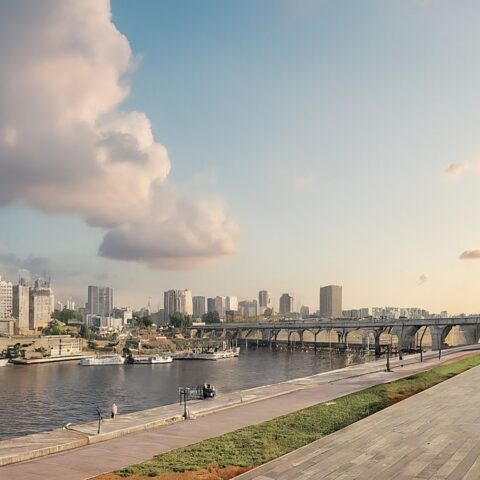The City of Hamilton set a record for construction value last year, reaching $2.5 billion — with more than $600 million of that occurring in the downtown core.
It’s the second time the total has surpassed $2 billion and it beat the previous high attained in 2021.
The city’s director of economic development, Norm Schleehahn, relayed that information as he welcomed almost 120 people who attended a May 10 tour of downtown Hamilton development and infrastructure projects.
The event featured a variety of speakers and was organized by Urban Land Institute Toronto and sponsored by Bousfields Inc., Invest in Hamilton and Urban Strategies Inc.
Schleehahn spoke at the West Harbour GO Transit station, which has offered travellers and commuters access to the core since 2015. Since 2023, the station has provided all-day service to and from Toronto’s Union Station for a growing number of commuters between the two cities.
Schleehahn also noted The Conference Board of Canada declared Hamilton to have the most diverse economy in Canada, another reason for businesses to move to or expand in the city of almost 600,000 people.
Coppley Building
A heritage building constructed in 1856 and expanded 50 years later, at 56 York Blvd. at the corner of MacNab Street North, was the home of high-end suit and jacket manufacturer Coppley Apparel until three years ago.
It’s now 80 per cent owned by Toronto development company TAS and 20 per cent owned by Hamilton Community Foundation, a charitable organization that contributes time, leadership and financial support to initiatives that benefit the community.
The project is part of TAS’ community hub strategy, which sees it lead the adaptive re-use, lease-up and operations of under-utilized warehouse spaces across the Greater Toronto and Hamilton Area. The primary restoration and renovation work will begin soon.
The goal is to restore the building’s original character and transform it into a new kind of community hub that will include a mix of commercial uses and tenants.
The building’s external features will be left intact as much as possible, as will the interior to retain an industrial look, but with modern energy efficiency, sustainability and technology elements.
106 Bay St. N.
Construction is expected to be completed this year on 106 Bay St. N., a six-storey, 51,760-square-foot purpose-built rental building.
The CityHousing Hamilton project will offer 35 one-bedroom units, 20 three-bedroom units, a ground-floor amenity space, outdoor garden space and six above-ground parking spots. Eighty-two per cent of the units will be classified as deeply affordable with rent geared to income and 18 per cent will be classified moderately affordable with half-market rent.

Toronto-based Kearns Mancini Architects designed 106 Bay St. N., a former parking lot acquired from the city in 2018, to Passive House standards. This emphasizes creating a healthy environment, equity, wellness, energy efficiency, resiliency and affordability.
Kearns Mancini CEO Jonathan Kearns said meeting Passive House standards can be achieved with a premium of less than three per cent above normal design and construction costs.
CityHousing Hamilton is the city’s largest social housing provider. It also provides additional programs and supports to tenants through partnerships with community agencies.
There are more than 13,000 tenants living in CityHousing Hamilton buildings and the properties have an estimated value of more than $1 billion.
A second phase, featuring underground parking accessible from Cannon Street, will be built in the future as part of 106 Bay St. N.
Downtown Entertainment Precinct
The City of Hamilton owns large parcels of land in the downtown core, including those occupied by the FirstOntario Centre arena, the Hamilton Convention Centre and the FirstOntario Concert Hall.
It reached an agreement last November for long-term land leases with Oak View Group (OVG) and Hamilton Urban Precinct Entertainment Group to begin almost $300 million in renovations to the arena to create a premier music, sports and entertainment destination.
OVG, headed by chairman and CEO Tim Leiweke, is the largest developer of sports and live entertainment venues in the world.
It plans to transform FirstOntario Centre into an 18,000-seat venue with a reimagined facade, premium seating, enhanced acoustics, improved sightlines, upgraded concourses, optimized clubs and suites, and artist lounges. Live Nation will be OVG’s booking partner for the venue.
The convention centre will also receive a $10 million facelift and improvements will be made to the concert hall as part of the greater overall effort to generate additional economic activity and excitement in the downtown core.
Hamilton senior project manager Phil Caldwell said Empire Communities acquired a nearby heritage church and plans to incorporate part of it into the development of two 30-storey residential towers on the site.
IN8 Developments has planning approval for a large mixed-use condominium development on the 3.54-acre site of the now-closed Hamilton City Centre shopping mall at 77 James St. N. as another component of growth plans in the immediate vicinity.
McMaster University’s 10 Bay Graduate Residence

McMaster University and Knightstone Capital launched a phased opening of a 30-storey building at 10 Bay St. in September to house upper-year students, graduate students and postdoctoral fellows in 644 bed spaces in fully furnished studio, one-bedroom and two-bedroom apartments. Fifteen per cent of the units are barrier-free.
The building’s amenities include: a fitness centre; an outdoor rooftop park with a running track and barbecue area; an arcade; lounge spaces; event spaces; communal kitchens; a movie theatre room; study and meeting spaces; a yoga and music room; a games room; and a convenience store.
Monthly rent includes all utilities, high-speed Internet, 24/7 building security and live-in McMaster residence support staff.
The building, located 110 metres from McMaster’s David Braley Health Sciences Centre, was designed by Diamond Schmitt. It meets LEED Gold standards and includes green roofs and bicycle storage.
The 416,000-square-foot building also includes a 265-stall commercial parking lot used as a revenue generator.
Toronto-based Knightstone was founded in 2001 and has built and managed more than $1.5 billion of academic, hospitality, commercial and residential developments. It partners with Canadian institutions — also including the University of Toronto and Centennial College — to create customized real estate solutions for on- and off-campus student housing.
Knightstone owns and manages a portfolio of mixed-use academic developments comprised of more than 3,100 beds within two million square feet. Another 2,000 beds are under development.
STAY TUNED FOR PART II: The second part of this article, to be published tomorrow, will explore current and proposed projects involving a light rail transit line, Augusta Developments, the Art Gallery of Hamilton, The King William and the King John Buildings.







